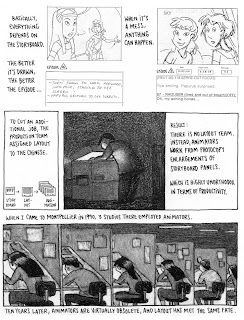 In this 1982 photo, that's Bob Jaques in the center. Behind him on the left is Dan Haskett and to the right is Chris Armstrong.
In this 1982 photo, that's Bob Jaques in the center. Behind him on the left is Dan Haskett and to the right is Chris Armstrong.I'm late mentioning this, but I wanted to dig up a visual to go with talking about Bob's new blog. I met Bob at Nelvana in Toronto in 1980 or '81. While I had come from New York and had worked in the New York animation industry, I was far more enamored of animation that had been made in L.A. To be honest, I looked down my nose at a lot of the people working in N.Y. animation.
My only excuse is that I was young and stupid. I came to realize that the difference between N.Y. and L.A. had more to do with opportunity than with talent. One of the people who wised me up was Bob.
Bob had stared at the Fleischer and Famous cartoons long and hard. Comparing what he saw on the screen with the sparse animator credits on those cartoons, he had methodically figured out how to recognize the styles of just about every animator. Bob was the one who opened my eyes to the brilliance of John Gentilella, an animator whose work was as good as anybody in California and done under much less friendly conditions.
Bob now has a blog dedicated to identifying the animators on the Popeye cartoons. As these cartoons are finally becoming available on DVD, his timing couldn't be better. (Bob has also done some audio commentaries for future Popeye DVD releases). New York animators never received the attention of their L.A. counterparts and were rarely interviewed. It's great that Bob is sharing his knowledge, filling in gaps in our understanding of the Fleischer/Famous animators.
My only excuse is that I was young and stupid. I came to realize that the difference between N.Y. and L.A. had more to do with opportunity than with talent. One of the people who wised me up was Bob.
Bob had stared at the Fleischer and Famous cartoons long and hard. Comparing what he saw on the screen with the sparse animator credits on those cartoons, he had methodically figured out how to recognize the styles of just about every animator. Bob was the one who opened my eyes to the brilliance of John Gentilella, an animator whose work was as good as anybody in California and done under much less friendly conditions.
Bob now has a blog dedicated to identifying the animators on the Popeye cartoons. As these cartoons are finally becoming available on DVD, his timing couldn't be better. (Bob has also done some audio commentaries for future Popeye DVD releases). New York animators never received the attention of their L.A. counterparts and were rarely interviewed. It's great that Bob is sharing his knowledge, filling in gaps in our understanding of the Fleischer/Famous animators.

















